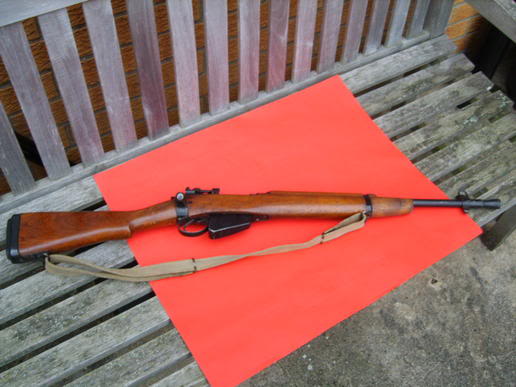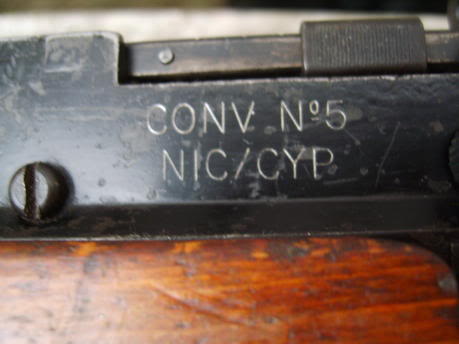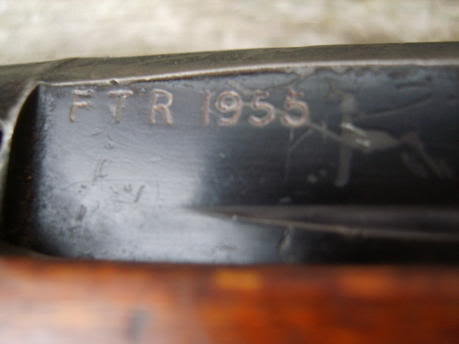-
Legacy Member

If anyone needs to copy the pictures or use them its ok for posting I am just curious as to the history of this rifle. So if I understand this right the ones in my photos are from possibly ones VT did.
-
-
02-22-2011 09:18 AM
# ADS
Friends and Sponsors

-
Advisory Panel



Originally Posted by
wheaty

PauL The ones JR at Victoria Trading got were from my contact in the
UK
.... There was less than a couple of hundred which is the reason why none of the bigger dealers touched them. Too small a lot to advertise.
Okay, I won't argue as I never saw one and never heard if they had import marks. VT pulled so many games, it is easy to believe the worst. If I remember correctly Springfield Sporters also told me VT bought No.5 parts from Numrich. I can't see them ever being collectible.
-
-
-
Legacy Member

So, Wheaty, are they genuine? Suspect? A complete fabrication of two Australian gunsmiths?
gunsmiths?
It would be good to see photos of the proof marks on masterdiver's rifle---the British commercial proof and any kind of mark on the barrel.
commercial proof and any kind of mark on the barrel.
-----krinko
-
-
Legacy Member

From what has been stated above, they are completely fabricated, by whom is still in question.
-
-
Legacy Member

"From what has been stated above..."
Oh, really, jona?
Where?
This bit seems to be the only first-hand experience---
"The carbines in question were purchased by a UK dealer back in the 80's. I'll check my travel doc's and give you a date, as I was there when the arrived at his warehouse. They ran from new to "bog standard" as was the expression at the time. IF memory serves me right, they came out of the east, and I am thinking India/Indonesia/Thailand area. If I have a chance I will call him and see if he remembers or will check his books, as this has been going on for a long time, trying to pin the damned things down as to origin. He gave me one at the time, so I will see if I can find it and post the markings. It was a "bog standard" but the price was right...free!!!! The days when you could bring something back on the airplane and they never batted an eye"---Fra Wheaty
dealer back in the 80's. I'll check my travel doc's and give you a date, as I was there when the arrived at his warehouse. They ran from new to "bog standard" as was the expression at the time. IF memory serves me right, they came out of the east, and I am thinking India/Indonesia/Thailand area. If I have a chance I will call him and see if he remembers or will check his books, as this has been going on for a long time, trying to pin the damned things down as to origin. He gave me one at the time, so I will see if I can find it and post the markings. It was a "bog standard" but the price was right...free!!!! The days when you could bring something back on the airplane and they never batted an eye"---Fra Wheaty
---doesn't seem to be anything unequivocal in there, not even the highlighted part, which starts out with a big "IF".
Perhaps there's an implication there---but I don't know Wheaty well enough to make an assumption and draw a conclusion.
Sorry.
-----krinko
-
-
Legacy Member

-
-
Advisory Panel


Cypriot? No. 5 Conversions
Oh no! They are back to haunt me again.
As to the origins of these conversions I can add nothing, but I do know a little about a batch of 28 of these things that VTC sent to California. Warren is correct, they did arrive in Vermont from the UK, through a British arms agent who supplied a lot of VTC's wares at the time.
JR told me on the phone that there were 145 of these conversions discovered in a warehouse in England which also held four or five hundred real No. 5 rifles. (Obvious question - why not buy those?) His possible origin theory, told with extensive qualifiers, revolved around British armorers stationed on Cyprus, but usually ended with, "Who knows?". Believe what you will about any of that, but what we do know, according to his newsletter/catalogs that I still have, is that his original, classic, "Pre-arrival" price was $275, then $350 after they got to Vermont, then finally rose to $399. A gunshop in the San Fernando Valley bought some of these and retailed them at $499.95.
which also held four or five hundred real No. 5 rifles. (Obvious question - why not buy those?) His possible origin theory, told with extensive qualifiers, revolved around British armorers stationed on Cyprus, but usually ended with, "Who knows?". Believe what you will about any of that, but what we do know, according to his newsletter/catalogs that I still have, is that his original, classic, "Pre-arrival" price was $275, then $350 after they got to Vermont, then finally rose to $399. A gunshop in the San Fernando Valley bought some of these and retailed them at $499.95.
As to the 28 I examined at length when they first got to California in early April of 1993, most had import marks, although some appeared to be lacking them. At this point in time, John Appleton of Fairfax, Virginia, since deceased, was handling VTC's UK imports, and, as my Envoy and Enforcer bear witness, Mr. Appleton's import stamp was, gratefully, very discrete and lightly struck, so perhaps the "unmarked" rifles really had instead, almost imperceptible, Appleton import marks.
The majority of these conversions were built on Longbranch No. 4 Mk I* actions, and, according to my notes made at the time, JR said about 20% of the 145 he imported were built on British receivers, which seemed to be the case with the ones I examined. My first thought after examining the 28 was that they certainly weren't the product of British armorers - a point not well received back in Vermont.
This group of conversions shared many characteristics. Judging by their condition, most seemed to have been built on well-used, No. 4 Mk I, No. 4 Mk I* and no. 4 Mk 1/2 actions, which had been re-barreled with newer, good condition, No. 4 barrels. None had matching bolts, although they had "supposedly" been re-headspaced. They all had brand-new locking bolts, (safeties), and new, Mk 3, or Mk 4, stamped rear sights. The new butt cap assembly was obviously an aftermarket product, but, if I remember correctly, the flash eliminators were new and genuine. All the wood had been converted to No. 5 configuration from No. 4 components. Some of the wood was walnut, but most was not. Although these rifles had obviously seen no use since conversion, the woodwork had obviously been converted from previously used components, with no new butts, fore-ends, or handguards, in evidence. All had the nice, fresh, "CONV No 5 NIC/CYP" markings stamped into the receiver wall.
None of this contributes to the origin answer, I know, and, although JR was a rather, "colorful" character, I saw his operation in Vermont at the time and he certainly didn't have the facility to make them there himself, so, with the evidence of the import marks, and Warren's statements, helping to corroborate the warehouse in England story, I think it is pretty safe to say that VTC got them from the UK. Where they were before that is anyone's guess, with Warren's view being better than most. It seems to me to be beyond the realm of coincidence for the markings to actually be, oh so conveniently, the initials of a couple of Aussie gunsmiths. Doesn't make a lot of sense economically either, as JR told me his wholesale price was only $150 each. That certainly couldn't leave much profit for two chaps in Australia to acquire at least 145 rifles and parts, spend the time, labor and material to convert them, then ship them all the way to the UK. A country with significantly lower labor and shipping costs than those of Australia would seem to be a much more logical candidate.
to acquire at least 145 rifles and parts, spend the time, labor and material to convert them, then ship them all the way to the UK. A country with significantly lower labor and shipping costs than those of Australia would seem to be a much more logical candidate.
Of the 28 I saw in April of '93, I acquired three for myself - two Longbranch's, (33L3240 and 60L5245), and what had been a Brit No. 4 Mk 1, (F28946A), that had been converted to a No. 4 Mk 1/2 in 1952, so obviously the No. 5 conversion was done well after 1952, judging by the 1/2 conversion date and the well-used condition of the receiver.
These rifles instantly became the subject of much controversy on the forums at the time, and, together with being told at the San Fernando Valley gunstore I mentioned earlier, of the flash eliminator on one of these rifles chasing a bullet down range, my initial doubts about them came to a head, and, for the first time in my life, I sold rifles out of my collection. As a very famous collector had previously bought the last of the 28, (and consequently the worst example), I don't feel too embarassed to have been temporarily mislead as to their authenticity. Out of respect for the man, I won't mention the name of famous collector who was also taken in, but rest assured, he doesn't subscribe to any of these forums.
Before anyone asks, I sold the last of these three rifles at the Phoenix gun show just a couple of years ago. (It took that long to convince myself I'd made a mistake in putting them in the collection, and then quite a while longer to unload them.) When I did sell them, I told the buyers upfront as much as I knew of their history and showed them the original Victoria Trading Company catalog, as well as what I thought of the accuracy of the printed advertisement. Cautioning the buyers that these were not collectibles, but rather something that would make a decent, knock-around, truck gun, I sold them very reasonably - $200 for the last one. My conscience wouldn't allow me to sell something that is so obviously a put-together, unless the buyer knew precisely what it was. Sure enough, those that bought them said a truck gun beater was exactly what they were looking for, so, what was initially a depressing, 15-year long story, finally had a happy ending when these rifles found homes where they are now used and appreciated for what they are.
As to how I acquired some of this knowledge, I have a worthless VTC stock certificate to remind me of an early investment error.
Hopefully there is something of worth here.
Terry
-
The Following 4 Members Say Thank You to Terry Hawker For This Useful Post:
-
Advisory Panel


If these rifles were put together in UK , it would explain why they bear the same style of pantograph engraving that appears on many other types of conversion and recreation....
, it would explain why they bear the same style of pantograph engraving that appears on many other types of conversion and recreation....
-
-
Legacy Member

First of all THANKS to all of you for responding and all the information that was passed on. I guess this will become a truck gun beater. I will be shooting it pretty soon so we see what kind of shooter it is. Special thanks again to Terry Hawker for all the background and Krinko for helping with this thread
-
-
I'm sure I wrote this one, earlier today but maybe I never hit the post reply button. But, the engraving on the top photo above of CONV No5 NIC/CYP has been done by what we call a 'scratchy pen' This is a diamond tipped pen, held in a panto frame but just scratches the surface. The sort of thing you'd use on jewellery or a present to the boss. These marks are probably not even .0005" deep at best. It is definately not a genuine factory or Base Workshop job where we used the real McCoy industrial pantograph engravers made by Taylor Hobson and these marked the steel as in the second photo (the commercial contract BSA FTR mark) with a high speed rotating cutter that cut fast and deep into the steel.
Anyway, that's my two pence worth!
-
The Following 3 Members Say Thank You to Peter Laidler For This Useful Post:














 PM
PM















